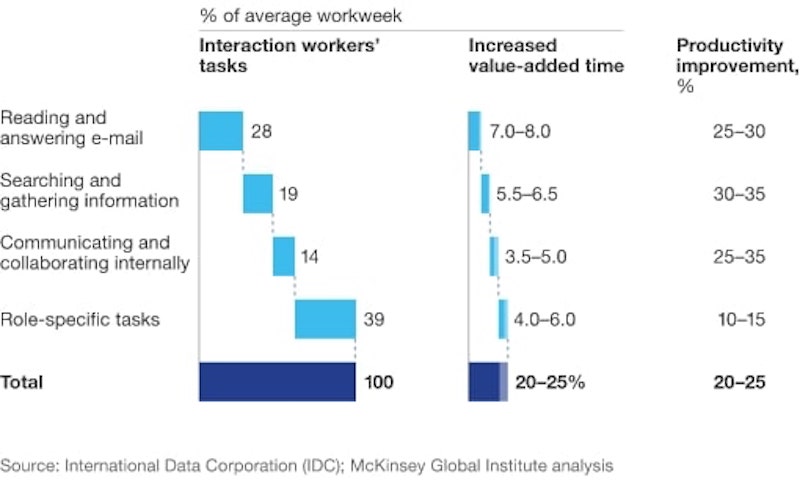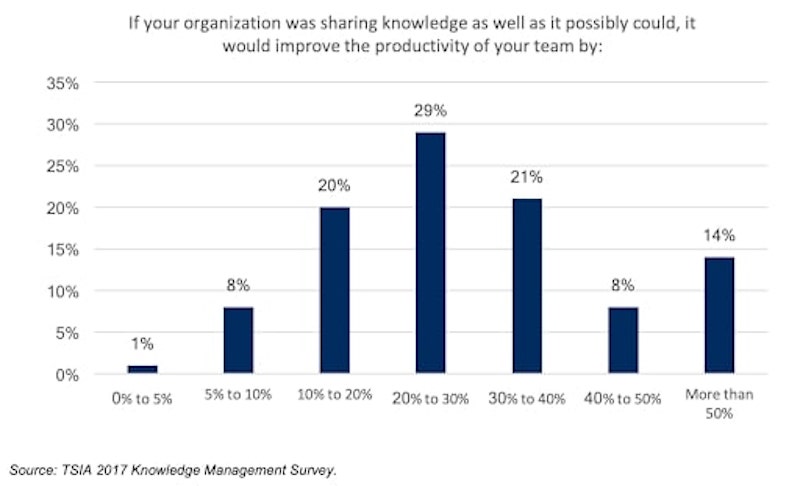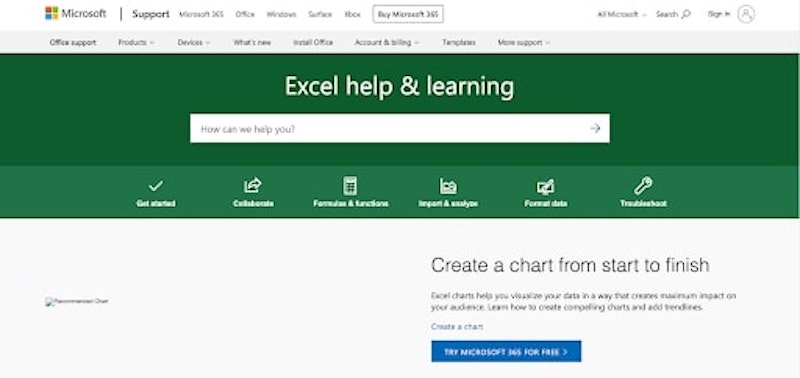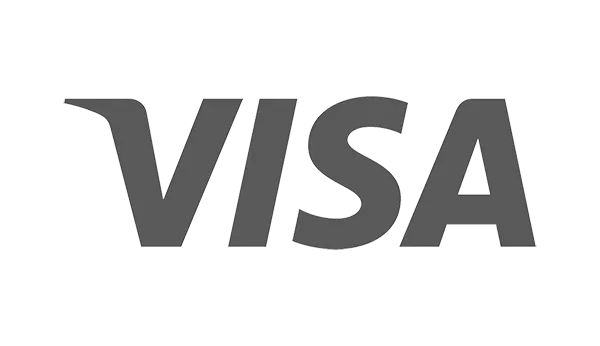Robust knowledge management can be a game-changer for your business, regardless of your industry, target audience, and product line.
When done right, knowledge management can save you plenty of cold, hard cash every year—over $300,000 in productivity costs—for a 100-person company. What’s more, a Panopto Workplace Knowledge and Productivity Report found businesses lose between $2.7 million and $265 million because of inefficient knowledge management.
This makes sense because everything that happens within your organization is based on data and knowledge.
- Your employees use knowledge to create and improve your products and services
- Your knowledge of customers’ requirements affects your ability to engage and provide value to them
- Your team’s knowledge of business and operational best practices drive your internal processes.
If you didn’t have this knowledge, your business wouldn't be able to function.
That’s why we’ve put together this detailed guide on knowledge management. Read on to know how to build and manage your own system to improve customer experience and decrease support costs.
What is Knowledge Management?

In the words of world-renowned thought leader and IT expert Tom Davenport, “Knowledge management is the process of capturing, distributing, and effectively using knowledge.“
To elaborate further, knowledge management is the practice of collecting, documenting, distributing, and applying a company’s knowledge and expertise for the collective benefit of an organization’s employees and customers.
It’s all about getting the right information to the right person at the right time.
With a robust knowledge management system in place, you can reinforce organizational learning and improve organizational practices for better outcomes—all the while saving time and effort of the involved people.
Some common knowledge management tools include knowledge bases, company FAQs, self-service portals, and community forums.
Why Knowledge Management is Important
Knowledge is your business’s most important tool, but it isn’t going to be any good when kept away in the toolshed.
The ultimate goal of knowledge management is to harness available intellectual and knowledge capital and channel it in a way that helps your organization and customers thrive. The benefits include:
- Delivering better customer experiences and faster resolution times through self-service
- Providing a consistent source of truth between customer support agents and customers
- Simplifying onboarding activities, processes, and goals, especially under remote conditions
According to McKinsey, robust knowledge management can reduce information search time by approximately 35% and increase organization-wide productivity by 20%-25%. You can use knowledge management software to provide employees access to its contents and solve problems themselves.

Moreover, it isn’t just employees who benefit from knowledge management—customers need it too.
Customers want to learn more about your company every time they look up your business on the internet. Knowledge management allows you to provide them with the right information, helping them determine whether your products and services meet their use-cases.
You can experiment with different knowledge management software and formats (blog posts, knowledge bases, case studies, white papers) to keep your audience informed, engaged, and trusting of your brand.
When Investing in Knowledge Management Makes Sense for Your Business

Knowledge management impacts productivity and profit, as well as customer and agent satisfaction. You implement a robust system, and you’ll strengthen your market position and bolster your growth; if you don’t, you may end up losing millions of dollars every year.
Below, we’ve discussed a few situations where investing in knowledge management makes sense.
Situation 1: To Preserve Your Employees’ Knowledge and Expertise
Experienced and talented employees deciding to work elsewhere or retiring is always bad news.
The employee takes their knowledge with them. You lose their on-the-job experience, expertise, and research, making daily operations without them an uphill battle. Finding someone to replace the experience the employee brought is also difficult.
Luckily, knowledge management allows organizations to document the know-how and experience of senior and talented employees. This way, the knowledge of the organization doesn’t leave when the employee does.
Plus, you can use the framework to get new hires up to speed with company norms and train them faster.
Situation 2: To Boost Team Productivity
TSIA found that over 70% of organizations believe improving their knowledge management efforts can increase their overall productivity.

How? Knowledge management lets your employees:
- Access step-by-step instructions and documentation outlining best practices for critical processes and tasks
- Use available tools and software to meet their goals faster and more efficiently
- Communicate and collaborate in real-time
Knowledge management is like a roadmap for your employees—your team will always know where they are going, and the best way to get there.
Situation 3: To Gain Competitive Advantage Over Your Competitors
Did you know over 30,000 new products are introduced every year, out of which 95% fail?
Inefficient knowledge management can lead to failed innovations. Your new product or service may fall short of customer expectations or be inferior to your competitors.
On the other hand, if you manage the knowledge and insights your company possesses properly, you can apply it in a way that helps your organization meet your customer’s needs better than your competition.
Additionally, prioritizing knowledge management can help you conduct valuable research, leading to more successful innovations and thus improved business performance.
Situation 4: To Accelerate Onboarding and Facilitate Remote Working

Knowledge management allows new hires access to all information and knowledge they need to start working from day 1. By going through all the organizational policies and market research reports, new employees will understand your company’s customer segments and target audience better.
Having a solid knowledge management system can be particularly useful for companies with remote or hybrid work cultures. It can improve access to information while promoting productivity, especially considering new employees wouldn’t have to ping a colleague every time they get stuck.
That said, all articles must be properly categorized and have comprehensive tutorials for this to work. For safety purposes, you can set rules and permissions to ensure only authorized individuals have access to sensitive content.
What Is a Knowledge Management System?
A knowledge management system or KMS is any kind of IT system, software, or tool that:
- stores and retrieves knowledge,
- improves collaboration and flow of information in an organization,
- locates knowledge sources, and
- facilitates better decision-making.
You’ll find tons of knowledge management systems, and while they may have different formats, they share a few common characteristics. These include:
- Webinars and case studies
- Certificates
- How-to articles and tutorials
- FAQs
- Education and training programs
- Community forums
Microsoft’s knowledge base is an excellent example of an effective knowledge management system.

Here, you’ll find helpful videos, training, and videos from product managers that help the user understand and use Microsoft’s products more effectively.
Features of a Knowledge Management System

IDC found knowledge workers spend 90% of their time looking for or creating information that already exists. A knowledge management system helps employees to use the already available knowledge to work more efficiently, plus focus the saved time and effort on more important aspects of their jobs.
But to get these advantages, you need a user-friendly and intuitive knowledge management tool.
Here’s a list of key features and tools to look for when setting up your team’s KMS.
- Rich Text Editor: Your content should include a mix of rich text, videos, and screenshots. Look for intuitive drag-and-drop tools that let you create this content without requiring developer support.
- Content Library: Having a content library will let you store your organization’s knowledge—documents, files, presentations, PDFs, videos, images, and audio—in one place. This will enable your team members and customers to access key information easily. A powerful search feature that helps them locate files faster is also useful.
- Flexible Permissions: A good KMS makes it easier for you to manage user controls and permission levels in a way that works best for your organizational structure. Look for features like password protection, file access restrictions, and document tracking to keep critical organizational data safe and secure.
- Multilingual Controls: Many KMS offer language translation tools that help you reach users in new markets. You can keep your articles localized and up-to-date and allow users to set default languages so that they can consume your knowledge natively.
- Feedback Tools: Feedback tools like a binary Yes/No form can tell you whether users found a given article helpful, which, in turn, lets you track the performance of your content. Similarly, you can have a ‘feature request’ submission system to collect feedback about the features your customers want.
- AI-powered Support: Having an advanced KMS can facilitate workflow automation and break down organizational silos. It can also provide the customer with AI-powered article suggestions for faster knowledge transfer and improved customer satisfaction.
How to Create a Knowledge Management Strategy

The very first step in implementing a knowledge management system is to build an effective knowledge management strategy. This involves the following steps:
Step 1: Determine Your Focus
Who are you creating your knowledge base for?
You may want to create an internal knowledge base for your teams to pull information from as they go about their duties. Or maybe you want to create a customer-facing KMS that allows your audience to troubleshoot problems and learn more information. Perhaps you want to accomplish both simultaneously.
Defining your rationale for creating a knowledge base will help you define your goals and milestones. Based on that, you can make continual improvements to your knowledge management initiatives for best results.
Step 2: Define the Roles of All Involved Parties
You want everyone on your team to be contributing to your KMS. Before that, however, you’ll have to determine each member’s role. Some of these roles are:
- Project managers, who oversee knowledge management initiatives specifically
- Knowledge finders, who are responsible for data and information discovery
- Knowledge communicators, who synthesize all information into usable knowledge
- Knowledge creators, who document all information for maximum accessibility
That said, the above roles aren’t set in stone. It’s better to keep the rules flexible and fluid and assign them to team members depending on the initiatives you undertake.
Step 3: Choose Relevant Tools and Technology
The best way to maximize your knowledge management-related initiatives is to take full advantage of the available tools and technology.
This will help enhance productivity and efficiency across your organization, plus promote self-service and provide automated support options to customers. These technologies can also be set up to streamline upkeep and maintenance, notify knowledge contributors to update articles, and verify the accuracy and relevance of the stored data.
6 Effective Steps for Creating a Knowledge Management Process

Once you have your knowledge management strategy set, you want to implement a KMS for creating knowledge and easily storing, organizing, and sharing it. Here’s how to go about that:
#1 Collect Data
Collect as much relevant data as you can on the topic in question. Think third-party industry reports, internal data, and customer feedback.
As the focus here is just on collecting the necessary information, you can have a broader perspective when going through different sources.
#2 Organize Data
The next step is to organize your collected data in a way that works best for you.
The way you prepare your data depends on your overall purpose. Below are a few tips:
- Create a data hierarchy based on your requirements
- Group your positive and negative customer reviews under different heads
- Rank all data by relevant metrics
Organize the collected data in a way that everyone understands its meaning.
#3 Summarize Information
Here, your goal is to establish the context of the data. When you summarize your findings in the most literal possible sense, you can extract even more information from the available data at a later stage.
Once all your findings are documented in an understandable and digestible manner, you can start to dig deeper.
#4 Analyze Information
At this stage, ask yourself some critical questions:
- Do you identify any trends when organizing the information under different heads?
- What kind of internal and external changes do you think may have contributed to these trends?
- Can you draw any correlations between data points that you may have previously overlooked?
Analyzing information will make your previously-isolated information more contextualized throughout the process.
#5 Synthesize Data Into Knowledge
Effective knowledge management is all about the effective harnessing of knowledge. That’s exactly what you’ll be doing here.
To synthesize data into knowledge, you’ll have to internalize the meaning behind your “on paper“ data. This will enable your organization and customers to use the information constructively.
How do you do that? Here are a few questions to get you started:
- Can you use the extracted information to improve your processes?
- Who and what tools will be involved in making these improvements?
- How will you assess the effectiveness of your efforts?
Done? Move on to the next step.
#6 Apply and Store Learned Knowledge
Once you have a clear idea of what you need to do, put your knowledge into action.
Knowledge is everlasting, but you still need to document and store it properly. This involves more than just preserving your knowledge—you also want credentialed stakeholders to update and edit said knowledge when needed.
Implementing a Knowledge Management System
Implementing a KMS is often a multidisciplinary and ongoing initiative, which is why you have to adopt a nuanced approach to build and maintain the necessary momentum to use your knowledge effectively.
Building a well-functioning knowledge base requires time and effort. But with the right software and tools, you can simplify and enhance knowledge sharing. So choose the best knowledge management software now and present knowledge as crisp and clean as possible for the best results.
Conclusion
With effective knowledge management, you can capture, distribute, and use your company’s experience and expertise to improve your product and services.
We hope our tips make it easier for you to implement a successful knowledge management system in your company and make use of your employees' collective knowledge.
Make developing a robust knowledge management strategy your top priority and empower your employees to go above and beyond to accomplish organizational goals.














